Top Rankings
Fall River Joint Unified School District ranks among the top 20% of public school district in California for:
Category
Attribute
Student Attention
Lowest student:teacher ratio (Top 1%)
For the 2025 school year, there are 7 public high schools serving 545 students in Fall River Joint Unified School District. This district's average high testing ranking is 5/10, which is in the bottom 50% of public high schools in California.
Public High Schools in Fall River Joint Unified School District have an average math proficiency score of 29% (versus the California public high school average of 28%), and reading proficiency score of 37% (versus the 51% statewide average).
Public High School in Fall River Joint Unified School District have a Graduation Rate of 70%, which is less than the California average of 87%.
The school with highest graduation rate is Burney Junior-senior High School, with ≥80% graduation rate. Read more about public school graduation rate statistics in California or national school graduation rate statistics.
Minority enrollment is 46% of the student body (majority Hispanic), which is less than the California public high school average of 79% (majority Hispanic).
Overview
This School District
This State (CA)
# Schools
11 Schools
2,817 Schools
# Students
1,160 Students
2,139,525 Students
# Teachers
68 Teachers
100,737 Teachers
Student : Teacher Ratio
17:1
17:1
District Rank
Fall River Joint Unified School District, which is ranked #1224 of all 1,925 school districts in California (based off of combined math and reading proficiency testing data) for the 2021-2022 school year.
The school district's graduation rate of 80-84% has decreased from 85-89% over five school years.
Overall District Rank
#1207 out of 1941 school districts
(Bottom 50%)
(Bottom 50%)
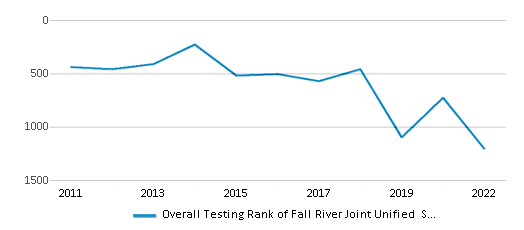
Math Test Scores (% Proficient)
26%
33%
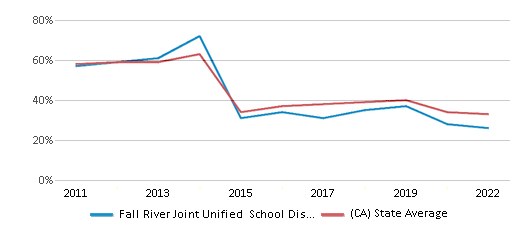
Reading/Language Arts Test Scores (% Proficient)
33%
47%
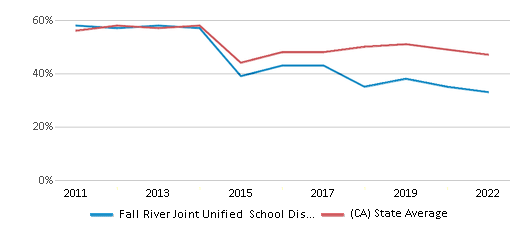
Science Test Scores (% Proficient)
20-24%
29%
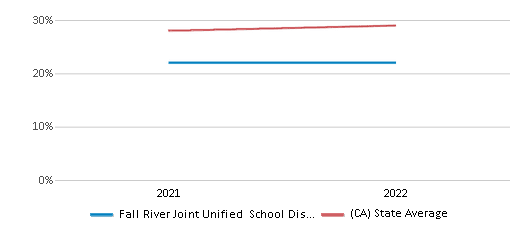
Graduation Rate
80-84%
87%
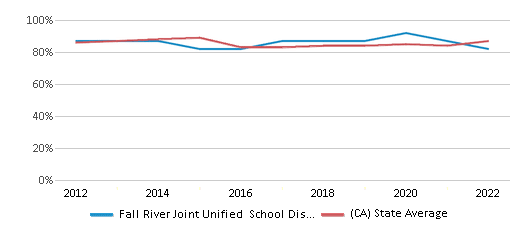
Students by Ethnicity:
Diversity Score
0.63
0.63
# American Indian Students
112 Students
10,468 Students
% American Indian Students
10%
1%
# Asian Students
1 Student
244,247 Students
% Asian Students
n/a
11%
# Hispanic Students
322 Students
1,190,384 Students
% Hispanic Students
28%
56%
# Black Students
2 Students
110,575 Students
% Black Students
n/a
5%
# White Students
619 Students
458,887 Students
% White Students
53%
22%
# Hawaiian Students
4 Students
9,060 Students
% Hawaiian Students
n/a
n/a
# Two or more races Students
100 Students
108,483 Students
% of Two or more races Students
9%
5%
Students by Grade:
# Students in PK Grade:
-
18
# Students in K Grade:
112
25,126
# Students in 1st Grade:
92
19,346
# Students in 2nd Grade:
91
19,826
# Students in 3rd Grade:
86
19,554
# Students in 4th Grade:
79
19,798
# Students in 5th Grade:
72
20,237
# Students in 6th Grade:
84
29,089
# Students in 7th Grade:
91
39,371
# Students in 8th Grade:
98
41,955
# Students in 9th Grade:
100
466,491
# Students in 10th Grade:
86
476,582
# Students in 11th Grade:
93
469,509
# Students in 12th Grade:
76
492,623
# Ungraded Students:
-
-
District Revenue and Spending
The revenue/student of $16,886 in this school district is less than the state median of $19,974. The school district revenue/student has stayed relatively flat over four school years.
The school district's spending/student of $16,211 is less than the state median of $18,396. The school district spending/student has stayed relatively flat over four school years.
Total Revenue
$20 MM
$116,387 MM
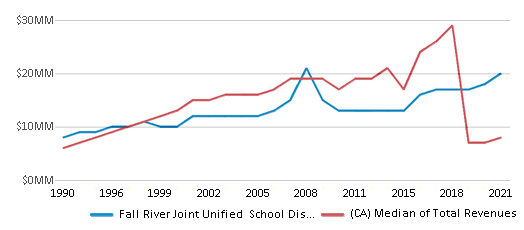
Spending
$19 MM
$107,188 MM
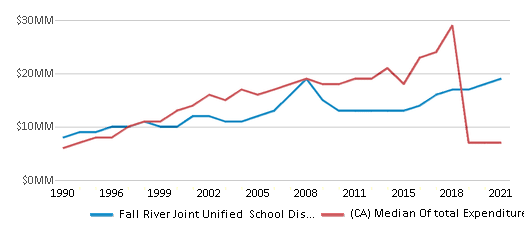
Revenue / Student
$16,886
$19,974

Spending / Student
$16,211
$18,396
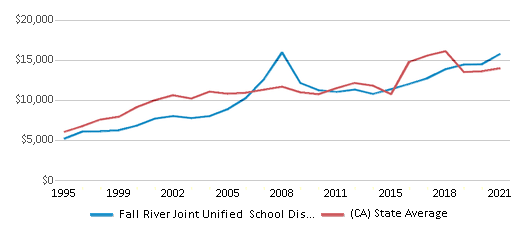
Best Fall River Joint Unified School District Public High Schools (2025)
School
(Math and Reading Proficiency)
(Math and Reading Proficiency)
Location
Grades
Students
Rank: #11.
Mt. Burney Special Education Center
Special Education School
(Math: <50% | Reading: <50% )
Rank:
Rank:
8/
Top 30%10
37577 Mountain View Rd.
Burney, CA 96013
(530) 335-3852
Burney, CA 96013
(530) 335-3852
Grades: K-12
| 4 students
Rank: #2 - 32. - 3.
Mountain View High (Continuation School)
Alternative School
(Math: <50% | Reading: <50% )
Rank:
Rank:
7/
Top 50%10
20375 Tamarack Ave.
Burney, CA 96013
(530) 335-5189
Burney, CA 96013
(530) 335-5189
Grades: 9-12
| 15 students
Rank: #2 - 32. - 3.
Soldier Mountain High (Continuation School)
Alternative School
(Math: <50% | Reading: <50% )
Rank:
Rank:
7/
Top 50%10
44144 A St.
Mcarthur, CA 96056
(530) 336-7159
Mcarthur, CA 96056
(530) 336-7159
Grades: 9-12
| 14 students
Rank: #44.
Fall River Junior-senior High School
(Math: 30-34% | Reading: 35-39%)
Rank:
Rank:
6/
Top 50%10
44215 Walnut St.
Mcarthur, CA 96056
(530) 336-5515
Mcarthur, CA 96056
(530) 336-5515
Grades: 7-12
| 238 students
Rank: #55.
Burney Junior-senior High School
(Math: 25-29% | Reading: 35-39%)
Rank:
Rank:
5/
Bottom 50%10
37571 Mountain View Rd.
Burney, CA 96013
(530) 335-4576
Burney, CA 96013
(530) 335-4576
Grades: 7-12
| 246 students
Rank: n/an/a
Burney Community Day
Alternative School
20375 Tamarack Ave.
Burney, CA 96013
(530) 335-5189
Burney, CA 96013
(530) 335-5189
Grades: 7-12
| 14 students
Rank: n/an/a
Fall River Community Day
Alternative School
44144 A St.
Mcarthur, CA 96056
(530) 336-7159
Mcarthur, CA 96056
(530) 336-7159
Grades: 7-12
| 14 students
Recent Articles

Year-Round Or Traditional Schedule?
Which is more appropriate for your child? A year-round attendance schedule or traditional schedule? We look at the pros and cons.

Why You Should Encourage Your Child to Join a Sports Team
Participating in team sports has a great many benefits for children, there is no doubt. In this article you will learn what those benefits are.

White Students are Now the Minority in U.S. Public Schools
Increasing birth rates among immigrant families from Asia and Central and South America, combined with lower birth rates among white families, means that for the first time in history, public school students in the United States are majority-minority. This shift in demographics poses difficulties for schools as they work to accommodate children of varying language abilities and socio-economic backgrounds.





